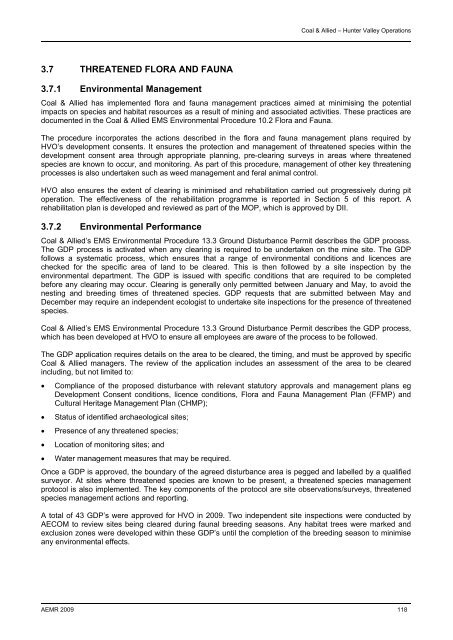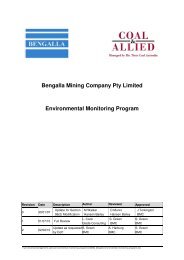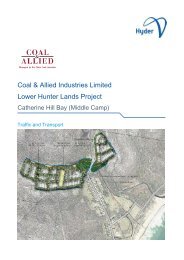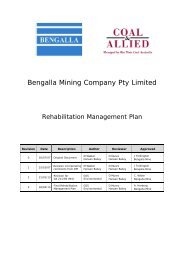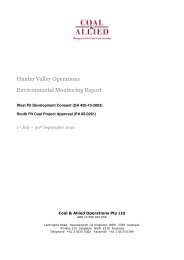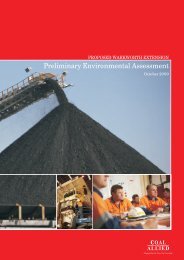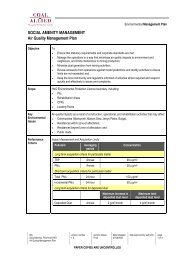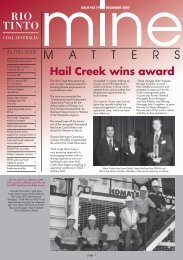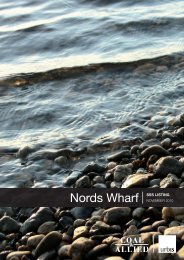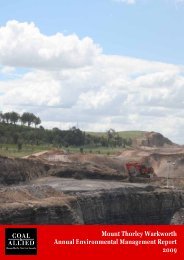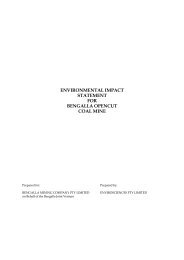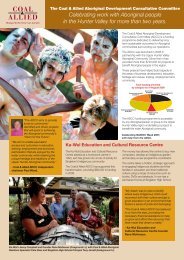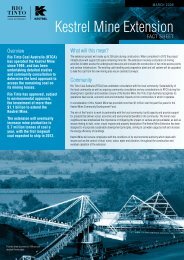HVO 2009 Annual Environmental Management Report - Final
HVO 2009 Annual Environmental Management Report - Final
HVO 2009 Annual Environmental Management Report - Final
You also want an ePaper? Increase the reach of your titles
YUMPU automatically turns print PDFs into web optimized ePapers that Google loves.
Coal & Allied – Hunter Valley Operations<br />
3.7 THREATENED FLORA AND FAUNA<br />
3.7.1 <strong>Environmental</strong> <strong>Management</strong><br />
Coal & Allied has implemented flora and fauna management practices aimed at minimising the potential<br />
impacts on species and habitat resources as a result of mining and associated activities. These practices are<br />
documented in the Coal & Allied EMS <strong>Environmental</strong> Procedure 10.2 Flora and Fauna.<br />
The procedure incorporates the actions described in the flora and fauna management plans required by<br />
<strong>HVO</strong>’s development consents. It ensures the protection and management of threatened species within the<br />
development consent area through appropriate planning, pre-clearing surveys in areas where threatened<br />
species are known to occur, and monitoring. As part of this procedure, management of other key threatening<br />
processes is also undertaken such as weed management and feral animal control.<br />
<strong>HVO</strong> also ensures the extent of clearing is minimised and rehabilitation carried out progressively during pit<br />
operation. The effectiveness of the rehabilitation programme is reported in Section 5 of this report. A<br />
rehabilitation plan is developed and reviewed as part of the MOP, which is approved by DII.<br />
3.7.2 <strong>Environmental</strong> Performance<br />
Coal & Allied’s EMS <strong>Environmental</strong> Procedure 13.3 Ground Disturbance Permit describes the GDP process.<br />
The GDP process is activated when any clearing is required to be undertaken on the mine site. The GDP<br />
follows a systematic process, which ensures that a range of environmental conditions and licences are<br />
checked for the specific area of land to be cleared. This is then followed by a site inspection by the<br />
environmental department. The GDP is issued with specific conditions that are required to be completed<br />
before any clearing may occur. Clearing is generally only permitted between January and May, to avoid the<br />
nesting and breeding times of threatened species. GDP requests that are submitted between May and<br />
December may require an independent ecologist to undertake site inspections for the presence of threatened<br />
species.<br />
Coal & Allied’s EMS <strong>Environmental</strong> Procedure 13.3 Ground Disturbance Permit describes the GDP process,<br />
which has been developed at <strong>HVO</strong> to ensure all employees are aware of the process to be followed.<br />
The GDP application requires details on the area to be cleared, the timing, and must be approved by specific<br />
Coal & Allied managers. The review of the application includes an assessment of the area to be cleared<br />
including, but not limited to:<br />
<br />
<br />
<br />
<br />
Compliance of the proposed disturbance with relevant statutory approvals and management plans eg<br />
Development Consent conditions, licence conditions, Flora and Fauna <strong>Management</strong> Plan (FFMP) and<br />
Cultural Heritage <strong>Management</strong> Plan (CHMP);<br />
Status of identified archaeological sites;<br />
Presence of any threatened species;<br />
Location of monitoring sites; and<br />
Water management measures that may be required.<br />
Once a GDP is approved, the boundary of the agreed disturbance area is pegged and labelled by a qualified<br />
surveyor. At sites where threatened species are known to be present, a threatened species management<br />
protocol is also implemented. The key components of the protocol are site observations/surveys, threatened<br />
species management actions and reporting.<br />
A total of 43 GDP’s were approved for <strong>HVO</strong> in <strong>2009</strong>. Two independent site inspections were conducted by<br />
AECOM to review sites being cleared during faunal breeding seasons. Any habitat trees were marked and<br />
exclusion zones were developed within these GDP’s until the completion of the breeding season to minimise<br />
any environmental effects.<br />
AEMR <strong>2009</strong> 118


